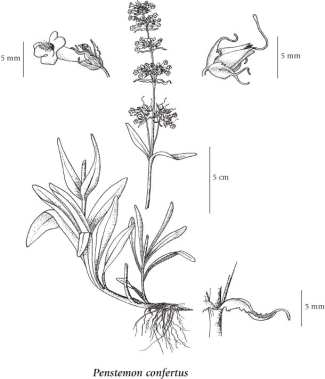Penstemon confertus Douglas ex Lindl.
yellow penstemon
Plantaginaceae (Mare's-tail family)
(Previously in Scrophulariaceae)
Introduction to Vascular Plants
yellow penstemon
Plantaginaceae (Mare's-tail family)
(Previously in Scrophulariaceae)
Introduction to Vascular Plants
Species Information click to expand contents
General:
Perennial herb from a woody stem-base, smooth throughout except for the flowers, or minutely hairy on the stems especially above; often with short leafy mat-forming stems at the base, the flowering stems usually several, clumped, ascending to erect but often decumbent-based, 10-50 cm tall, slender.
Leaves:
Basal leaves stalked, lanceolate to spoon-shaped, 3-10 cm long, entire, occasionally poorly developed; stem leaves opposite, narrowly lanceolate, entire, unstalked, slightly smaller than the basal leaves.
Flowers:
Inflorescence a slender terminal cluster, interrupted below, of 2 to 10 dense whorls of several stalked flowers, the bracts with papery and ragged margins; corollas narrowly tubular, 0.8-1.2 cm long, sulphur-yellow to yellowish-white, 2-lipped, smooth on the outside, hairy within at the throat; calyces 3-5 mm long, 5-lobed, the lobes lanceolate to oblong, abruptly long-pointy-tipped, the margins broad-papery and ragged; fertile stamens 4, the anthers smooth; sterile stamen about as long as the fertile stamens, brownish-bearded at its expanded tip.
Fruits:
Capsules, 4-5 mm long; seeds numerous, 0.5-1 mm long.
Illustration click to expand contents

If more than one illustration is available for a species (e.g., separate illustrations were provided for two subspecies) then links to the separate images will be provided below. Note that individual subspecies or varietal illustrations are not always available.
Illustration Source: The Illustrated Flora of British Columbia
USDA Species Characteristics click to expand contents
Flower Colour:
Yellow
Blooming Period:
Mid Summer
Fruit/Seed characteristics:
Colour: Brown
Present from Spring to Fall
Source: The USDA
Ecology click to expand contents
Ecological Framework for Penstemon confertus
The table below shows the species-specific information calculated from
original data (BEC database) provided by the BC Ministry of Forests and Range.
(Updated August, 2013)
The table below shows the species-specific information calculated from
original data (BEC database) provided by the BC Ministry of Forests and Range.
(Updated August, 2013)
| Site Information |
Value / Class |
||
|
Avg |
Min |
Max |
|
| Elevation
(metres) |
1287 | 365 | 2563 |
| Slope
Gradient (%) |
27 | 0 | 101 |
|
Aspect (degrees) |
197 | 5 | 360 |
| Soil
Moisture Regime (SMR) [0 - very xeric; 4 - mesic; 8 - hydric] |
2 | 0 | 5 |
| Modal
Nutrient Regime
Class |
C | ||
| #
of field plots species was recorded in: |
625 | ||
| Modal
BEC Zone Class |
IDF | ||
|
All BEC Zones (# of stations/zone) species was recorded in |
AT(6), BG(1), ESSF(154), ICH(2), IDF(223), IMA(7), MH(1), MS(101), PP(117) | ||
|
Source:
Klinkenberg 2013
|
|||
Habitat and Range click to expand contents
Moist to dry meadows, grassy openings and open forests in the steppe and montane zones; frequent in S BC east of the Coast-Cascade Mountains; E to MB and S to MT, ID and OR.
Status Information click to expand contents
Taxonomic Notes click to expand contents
The yellow penstemon usually has yellow flowers, but some plants and populations have pink flowers. One such population has been found at the top of Yahk Mountain, east of Creston. There are several species of small-flowered penstemons in British Columbia that are rather similar and that are usually constant in flower colour but have some varieties or populations that differ. The genetic and evolutionary significance of this has not been studied, but it should be interesting from the point of view of pollination ecology, possible hybridization, and evolutionary diversification. For example, the unusual flower colours might be the result of adaptation to different pollination insects, or they might allow the insects to discriminate between the different populations. Or perhaps the unusual flower colours are the result of hybridization between species that have flowers of a different colour.
Source: Griffiths and Ganders 1983. Wildflower Genetics: A field guide for British Columbia and the Pacific Northwest. |
References click to expand contents
Griffiths, Anthony F. and Fred R. Ganders. 1983. Wildflower Genetics: A Field Guide for British Columbia and the Pacific Northwest. Flight Press, Vancouver.